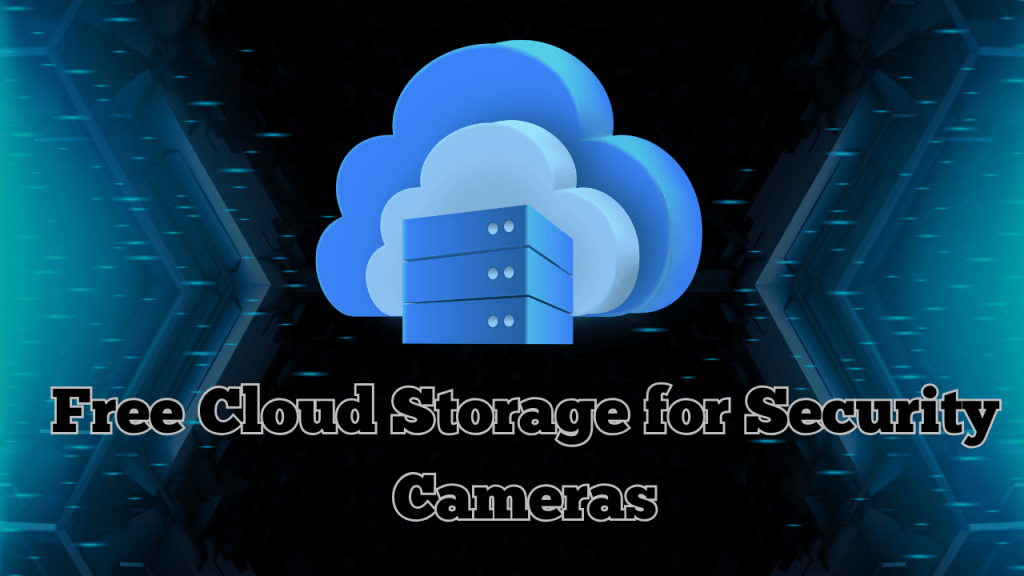What if your security camera captured a break-in… but the footage was lost forever?”
Imagine this—it’s 3 AM, and your security camera detects a suspicious movement outside your home. But what if your camera’s local storage gets damaged or stolen? All that crucial footage could be gone forever. That’s where cloud storage for security cameras comes in—your 24/7 safety net.
That’s exactly why cloud storage has become a big deal in the world of home and business security. If you’re using or planning to buy a wireless security camera, you’ve probably seen the term “cloud storage” mentioned everywhere. But what exactly is it? And do you really need it?
Cloud storage means your security camera saves videos online instead of (or in addition to) a memory card, DVR, or NVR at home. The footage is stored on secure servers managed by the camera brand or a third-party provider. This way, even if your camera or local storage device is damaged, you can still access your recordings anytime from your phone or computer.
Why is it needed? If you want extra safety for your video files, cloud storage is the smart choice. Local storage is cheaper (you buy an SD card or hard drive once), but it’s risky because the data is stored in one physical place. Cloud storage keeps your footage safe from theft, fire, or hardware failure.
Can you go without it? Yes, but there’s a trade-off. If your camera relies only on local storage and something happens to it, you might lose all your recordings. That’s why many people use both local and cloud storage together for double protection.
Cost: Cloud storage for security cameras usually works on a monthly subscription basis. Prices vary depending on how many days of video history you want to keep. The lowest plans often start around $3–$5 per month per camera, and can go higher for longer storage periods or more advanced features.
How does it work? Your camera uploads the recorded video clips or continuous footage to the cloud through your internet connection. You can then log in to an app or website to watch, download, or share the recordings from anywhere.
Cloud vs. Local Storage (Shortly):
- Cloud Storage: Safe from physical damage, accessible from anywhere, requires internet, ongoing cost.
- Local Storage: One-time cost, no internet needed for storage, but vulnerable to theft or damage.
Cloud storage isn’t mandatory, but it’s like having an insurance policy for your security footage — you hope you never need it, but when you do, it can save the day.
Why Security Cameras Need Cloud Backup – And Who Needs It Most?
Cloud backup for security cameras ensures your footage is stored safely online, protected from theft, damage, or system failures. If a camera or recorder is stolen or destroyed, your videos remain accessible anytime, anywhere. This makes it especially valuable for business owners, high-security facilities, and homeowners in crime-prone areas, where losing footage could mean losing vital evidence.
On the other hand, cloud storage may be less essential for people with reliable local storage setups, such as NVR/DVR systems or large-capacity SD cards, especially in low-risk areas. These users might prefer local solutions to avoid subscription costs and internet dependency.
Cloud backup is a must for anyone who values off-site safety, remote access, and added peace of mind, while those in safer locations with strong local storage might only use it as a secondary option.
Free Cloud Storage for Security Cameras

Cloud storage is becoming a popular choice for storing security camera footage. It allows you to access recordings anytime and anywhere, without worrying about losing them due to hardware failure or theft. But the big question is — can you really get free cloud storage for your security camera? The answer is yes, but with some limitations.
Is Free Cloud Storage Really Available?
Some security camera brands do offer free cloud storage, but usually with restricted features. For example, you might get only 24 hours to 7 days of storage, or your videos may be stored at a lower resolution. This is fine for basic monitoring, but it’s not suitable if you need long-term records.
Lifetime Free Cloud Storage — Is It True?
A few brands claim to offer free lifetime cloud storage, but this often means only short motion-triggered clips, usually lasting 10–30 seconds, rather than continuous video. Always read the terms carefully before buying.
Alternatives to Free Cloud Storage
If your free cloud storage is too limited, there are several alternatives:
- MicroSD Cards – Store footage directly inside the camera.
- NVR/DVR Systems – Record and save to a hard drive at home.
- NAS (Network Attached Storage) – Offers more flexibility and expandable capacity.
These options don’t depend on internet service and can be cheaper in the long run.
Automatic Deletion of Footage
Most free cloud storage plans automatically delete old footage after a set period, usually between 1 and 7 days. If you want to keep important clips, you’ll need to download them quickly before they are removed.
Popular Free Cloud Storage Options
Some examples of brands offering free cloud plans include:
- Wyze – 14 days of free motion-triggered clips.
- Eufy – No subscription for certain camera models.
- Arlo – Free limited plans for older devices.
These options work well for casual users who only need short-term storage.
Safety Concerns
Free cloud storage can be safe, but no system is completely hack-proof. Use strong passwords, enable two-factor authentication, and update your camera’s firmware regularly to reduce risks.
Can You Use Google Photos or OneDrive?
Yes, but only if your camera allows manual uploads. You would need to download the clips first and then upload them yourself. This process is not automated and is less convenient for 24/7 recording.
Free vs. Paid Cloud Storage
Free cloud storage is cost-free and perfect for light use, but it comes with limits in storage time and features. Paid plans offer longer retention, higher video quality, and extra features, but they require a monthly fee. For the best protection, many users combine local storage with a paid cloud plan.
Cons of Using Cloud Storage for Security Footage
While cloud storage is convenient, it has several drawbacks worth considering. One major downside is the monthly subscription fee, which can become expensive if you need long-term storage or have multiple cameras. Cloud storage also depends entirely on your internet connection — if your internet is slow or goes down, footage may fail to upload, creating security gaps. There’s the added risk of hacking or data breaches, as no system is 100% safe from cyberattacks. Many free or low-cost plans also have limited retention periods, meaning old videos are automatically deleted after a few days. Finally, privacy concerns remain, since your footage is stored on third-party servers, requiring you to trust an external provider with sensitive video data.
5 Reasons Why Cloud Storage for Security Footage May Not Be the Best Choice
- Ongoing Monthly Subscription Costs
- Full Dependence on Internet Connection
- Risk of Hacking and Data Breaches
- Limited Storage Retention Periods
- Privacy Concerns with Third-Party Servers
Pros of Using Cloud Storage for Security Footage
Cloud storage offers several benefits that make it a popular choice for storing security camera recordings. The biggest advantage is easy access from anywhere — you can view your footage on a phone, tablet, or computer, no matter where you are. It also protects against physical damage or theft, since the videos are stored securely online instead of on a device at home.
Another benefit is automatic backups. Your footage uploads in real time, so you don’t have to worry about losing data due to hardware failure. Cloud storage is also scalable, meaning you can easily increase your storage space when needed without buying new equipment.
Many services include extra features, such as motion alerts, AI-based detection, and easy clip sharing. Overall, cloud storage gives you convenience, flexibility, and added security for your valuable video footage.
5 Reasons Why Cloud Storage Is a Smart Choice for Security Footage
- Access Footage Anytime, Anywhere – View recordings from your phone, tablet, or computer, no matter where you are.
- Protection from Theft or Damage – Videos stay safe online even if your camera or recorder is stolen or damaged.
- Automatic Backups – Footage uploads instantly, reducing the risk of losing important recordings.
- Scalable Storage – Easily increase your storage space without buying new hardware.
- Extra Features – Enjoy benefits like motion alerts, AI detection, and easy clip sharing.
About Do Security Cameras Need Cloud Storage?
Is cloud storage necessary for security cameras?
Cloud storage isn’t always necessary, but it offers easy remote access, backup protection, and saves local space. For basic monitoring, local storage may be enough, but cloud storage adds convenience and safety.
Can I get free cloud storage for my security camera?
Yes, some brands provide free cloud storage plans, usually limited by storage time or video quality. However, these free plans often delete footage after a few days and may not support continuous recording.
What are the risks of using cloud storage for security footage?
Cloud storage depends on internet connectivity, may involve monthly fees, and poses potential risks of hacking. Also, privacy concerns arise since your footage is stored on third-party servers.
Can I use Google Photos or OneDrive to store security camera videos?
Technically yes, if your camera supports manual uploads, but this is not automated and less convenient for continuous recording compared to dedicated cloud services.
What are good alternatives if I don’t want cloud storage?
A5: You can use local options like microSD cards inside cameras, NVR/DVR systems, or Network Attached Storage (NAS) devices to store footage without relying on the internet.
